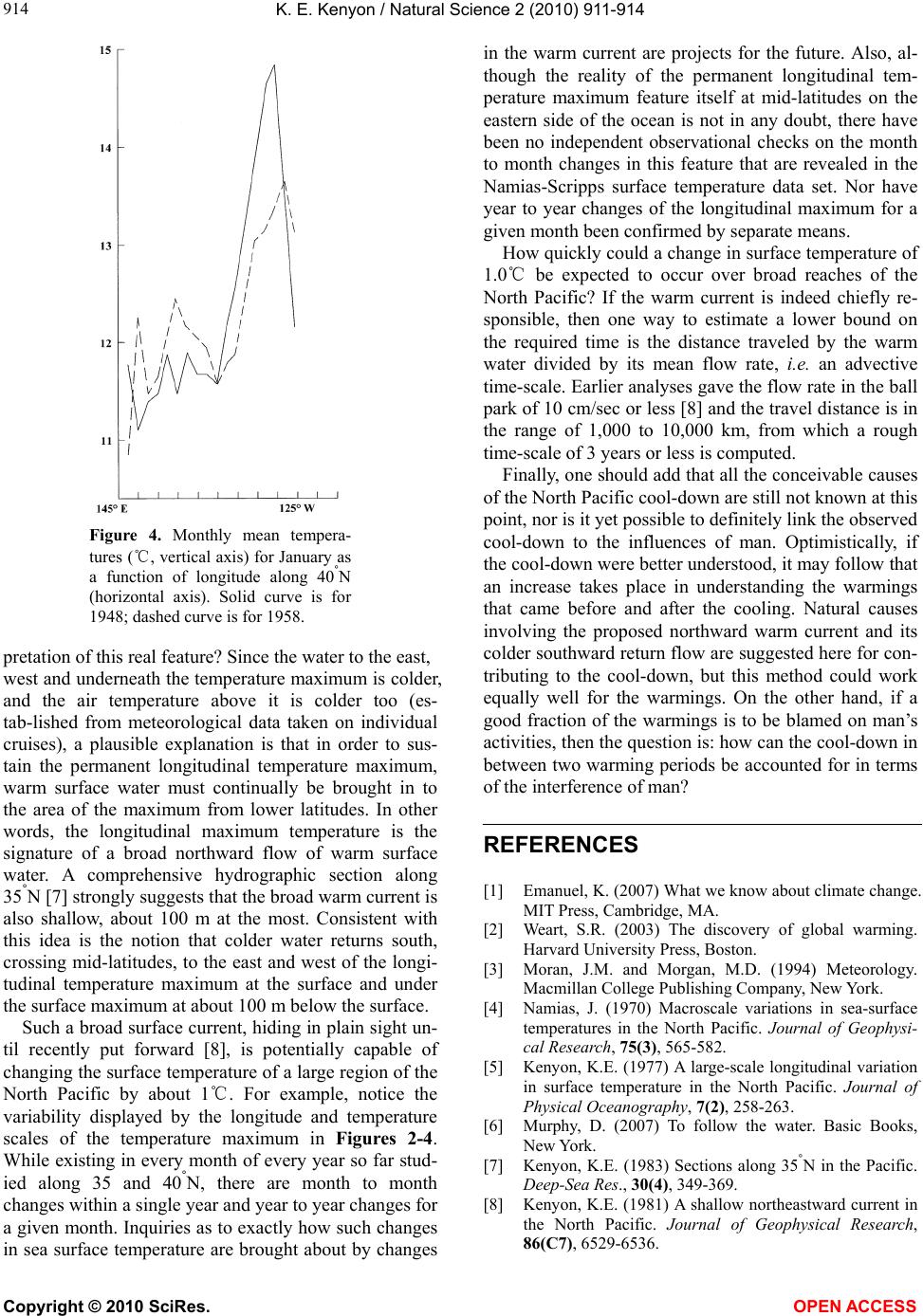
K. E. Kenyon / Natural Science 2 (2010) 911-914
Copyright © 2010 SciRes. OPEN ACCESS
914
Figure 4. Monthly mean tempera-
tures (℃, vertical axis) for January as
a function of longitude along 40°N
(horizontal axis). Solid curve is for
1948; dashed curve is for 1958.
pretation of this real feature? Since the water to the east,
west and underneath the temperature maximum is colder,
and the air temperature above it is colder too (es-
tab-lished from meteorological data taken on individual
cruises), a plausible explanation is that in order to sus-
tain the permanent longitudinal temperature maximum,
warm surface water must continually be brought in to
the area of the maximum from lower latitudes. In other
words, the longitudinal maximum temperature is the
signature of a broad northward flow of warm surface
water. A comprehensive hydrographic section along
35°N [7] strongly suggests that the broad warm current is
also shallow, about 100 m at the most. Consistent with
this idea is the notion that colder water returns south,
crossing mid-latitudes, to the east and west of the longi-
tudinal temperature maximum at the surface and under
the surface maximum at about 100 m below the surface.
Such a broad surface current, hiding in plain sight un-
til recently put forward [8], is potentially capable of
changing the surface temperature of a large region of the
North Pacific by about 1℃. For example, notice the
variability displayed by the longitude and temperature
scales of the temperature maximum in Figures 2-4.
While existing in every month of every year so far stud-
ied along 35 and 40°N, there are month to month
changes within a single year and year to year changes for
a given month. Inquiries as to exactly how such changes
in sea surface temperature are brought about by changes
in the warm current are projects for the future. Also, al-
though the reality of the permanent longitudinal tem-
perature maximum feature itself at mid-latitudes on the
eastern side of the ocean is not in any doubt, there have
been no independent observational checks on the month
to month changes in this feature that are revealed in the
Namias-Scripps surface temperature data set. Nor have
year to year changes of the longitudinal maximum for a
given month been confirmed by separate means.
How quickly could a change in surface temperature of
1.0℃ be expected to occur over broad reaches of the
North Pacific? If the warm current is indeed chiefly re-
sponsible, then one way to estimate a lower bound on
the required time is the distance traveled by the warm
water divided by its mean flow rate, i.e. an advective
time-scale. Earlier analyses gave the flow rate in the ball
park of 10 cm/sec or less [8] and the travel distance is in
the range of 1,000 to 10,000 km, from which a rough
time-scale of 3 years or less is computed.
Finally, one should add that all the conceivable causes
of the North Pacific cool-down are still not known at this
point, nor is it yet possible to definitely link the observed
cool-down to the influences of man. Optimistically, if
the cool-down were better understood, it may follow that
an increase takes place in understanding the warmings
that came before and after the cooling. Natural causes
involving the proposed northward warm current and its
colder southward return flow are suggested here for con-
tributing to the cool-down, but this method could work
equally well for the warmings. On the other hand, if a
good fraction of the warmings is to be blamed on man’s
activities, then the question is: how can the cool-down in
between two warming periods be accounted for in terms
of the interference of man?
REFERENCES
[1] Emanuel, K. (2007) What we know about climate change.
MIT Press, Cambridge, MA.
[2] Weart, S.R. (2003) The discovery of global warming.
Harvard University Press, Boston.
[3] Moran, J.M. and Morgan, M.D. (1994) Meteorology.
Macmillan College Publishing Company, New York.
[4] Namias, J. (1970) Macroscale variations in sea-surface
temperatures in the North Pacific. Journal of Geophysi-
cal Research, 75(3), 565-582.
[5] Kenyon, K.E. (1977) A large-scale longitudinal variation
in surface temperature in the North Pacific. Journal of
Physical Oceanography, 7(2), 258-263.
[6] Murphy, D. (2007) To follow the water. Basic Books,
New York.
[7] Kenyon, K.E. (1983) Sections along 35°N in the Pacific.
Deep-Sea Res., 30(4), 349-369.
[8] Kenyon, K.E. (1981) A shallow northeastward current in
the North Pacific. Journal of Geophysical Research,
86(C7), 6529-6536.